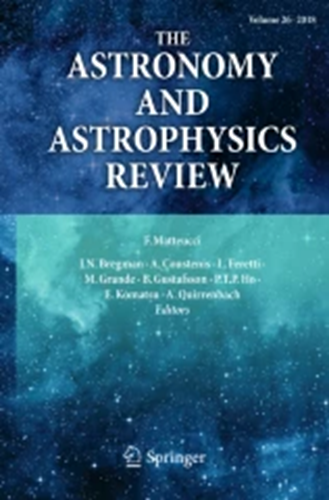Convective core sizes in rotating massive stars
IF 27.8
1区 物理与天体物理
Q1 ASTRONOMY & ASTROPHYSICS
引用次数: 7
Abstract
Spectroscopic studies of Galactic O and B stars show that many stars with masses above 8 M$_{\odot}$ are observed in the HR diagram just beyond the Main-Sequence (MS) band predicted by stellar models computed with a moderate overshooting. This may be an indication that the convective core sizes in stars in the upper part of the HR diagram are larger than predicted by these models. Combining stellar evolution models and spectroscopic parameters derived for a large sample of Galactic O and B stars, including brand new information about their projected rotational velocities, we reexamine the question of the convective core size in MS massive stars. We confirm that for stars more massive than about 8 M$_{\odot}$, the convective core size at the end of the MS phase increases more rapidly with the mass than in models computed with a constant step overshoot chosen to reproduce the main sequence width in the low mass range (around 2 M$_{\odot}$). This conclusion is valid for both the cases of non-rotating models and rotating models either with a moderate or a strong angular momentum transport. The increase of the convective core mass with the mass obtained from the TAMS position is, however, larger than the one deduced from the surface velocity drop for masses above about 15 M$_{\odot}$. Although observations available at the moment cannot decide what is the best choice between the core sizes given by the TAMS and the velocity drop, we discuss different methods to get out of this dilemma. At the moment, comparisons with eclipsing binaries seem to favor the solution given by the velocity drop. While we confirm the need for larger convective cores at higher masses, we find tensions in-between different methods for stars more massive than 15 M$_{\odot}$. The use of single-aged stellar populations (non-interacting binaries or stellar clusters) would be a great asset to resolve this tension.旋转大质量恒星的对流核大小
银河系O星和B星的光谱研究表明,在HR图中观测到许多质量超过800 M$ {\odot}$的恒星,正好超出了由恒星模型计算的主序(MS)带。这可能表明HR图上部恒星的对流核尺寸比这些模型预测的要大。结合恒星演化模型和银河系O星和B星大样本的光谱参数,包括它们预计旋转速度的全新信息,我们重新审视了MS大质量恒星对流核心大小的问题。我们证实,对于质量大于800 M$_{\odot}$的恒星,在MS阶段结束时对流核心的大小随质量的增加比选择恒定步进超调来重现低质量范围(约200 M$_{\odot}$)的主序列宽度的模型更快。这一结论对非旋转模型和具有中等或强角动量输运的旋转模型都有效。然而,从TAMS位置得到的对流核质量随质量的增加,要大于从15m以上质量的表面速度下降得到的增加。虽然目前可用的观测结果无法决定TAMS给出的堆芯尺寸和速度降之间的最佳选择,但我们讨论了不同的方法来摆脱这一困境。目前,与食双星的比较似乎倾向于速度下降给出的解决方案。虽然我们确认在更高的质量下需要更大的对流核心,但我们发现对于质量大于15 M的恒星,不同方法之间存在张力。使用单一年龄的恒星群(非相互作用的双星或星团)将是解决这种紧张关系的重要资产。
本文章由计算机程序翻译,如有差异,请以英文原文为准。
求助全文
约1分钟内获得全文
求助全文
来源期刊

The Astronomy and Astrophysics Review
地学天文-天文与天体物理
CiteScore
45.00
自引率
0.80%
发文量
7
期刊介绍:
The Astronomy and Astrophysics Review is a journal that covers all areas of astronomy and astrophysics. It includes subjects related to other fields such as laboratory or particle physics, cosmic ray physics, studies in the solar system, astrobiology, instrumentation, and computational and statistical methods with specific astronomical applications. The frequency of review articles depends on the level of activity in different areas. The journal focuses on publishing review articles that are scientifically rigorous and easily comprehensible. These articles serve as a valuable resource for scientists, students, researchers, and lecturers who want to explore new or unfamiliar fields. The journal is abstracted and indexed in various databases including the Astrophysics Data System (ADS), BFI List, CNKI, CNPIEC, Current Contents/Physical, Chemical and Earth Sciences, Dimensions, EBSCO Academic Search, EI Compendex, Japanese Science and Technology, and more.
 求助内容:
求助内容: 应助结果提醒方式:
应助结果提醒方式:


